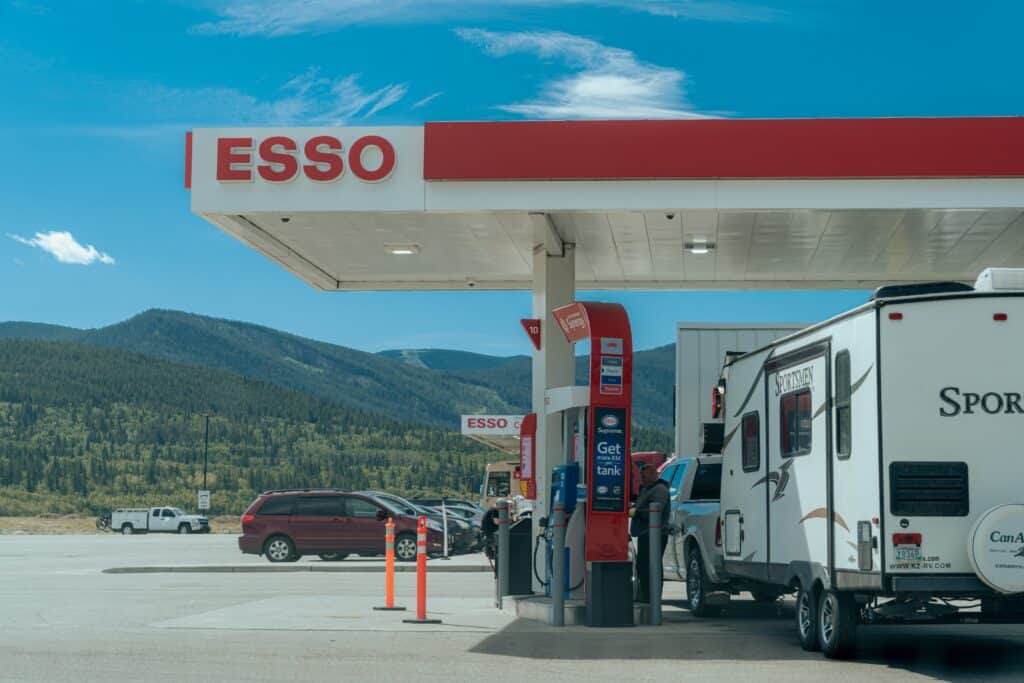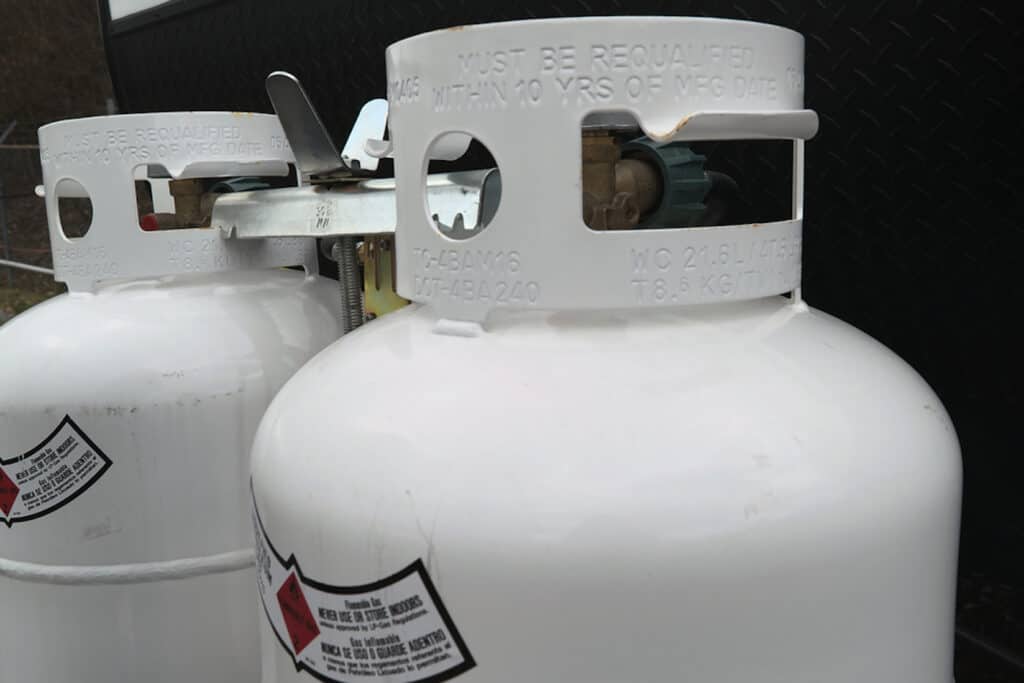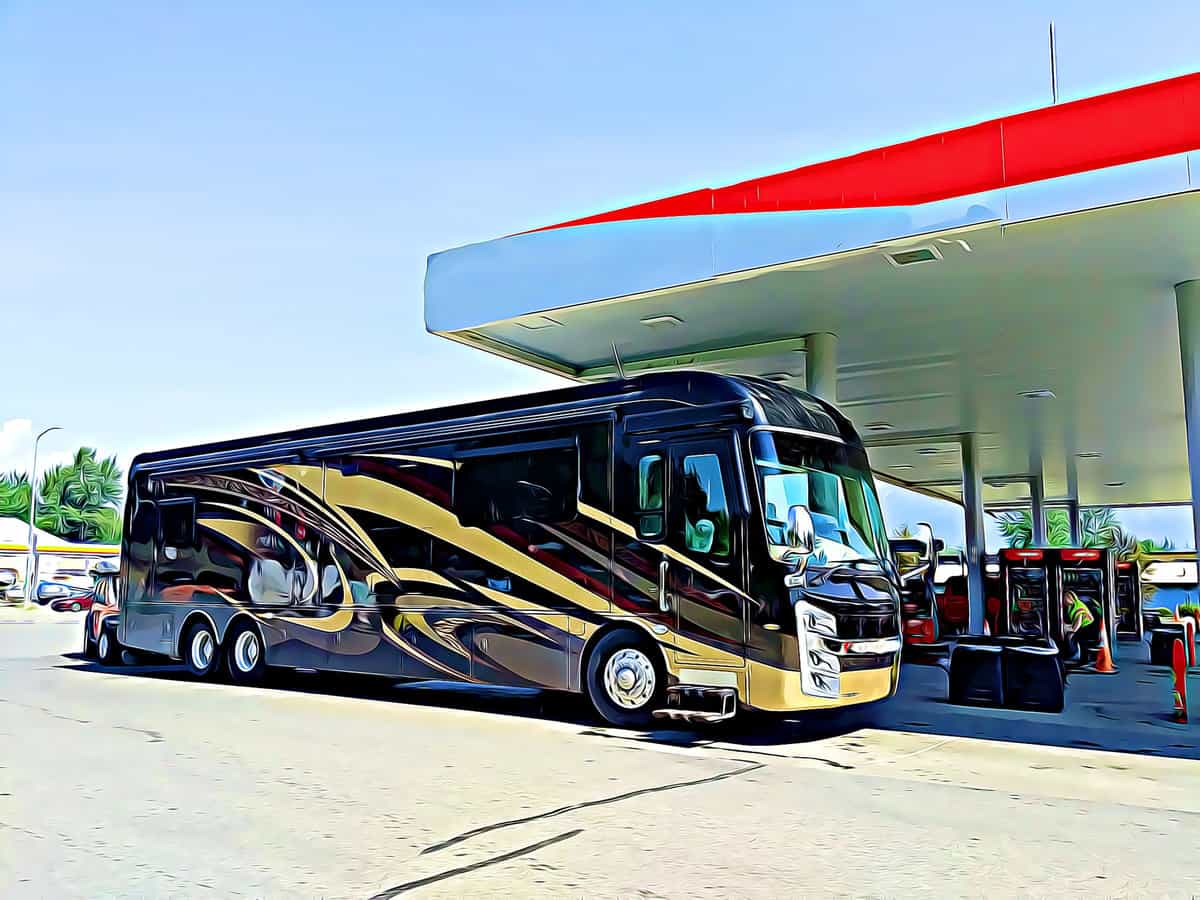
Should You Get Premium Gas For Your Vehicle?
Whenever you fuel up your RV, you get to choose between regular unleaded and several grades of premium gas. All the marketing hype around higher grades of fuel can have you wondering if the upgrade to premium gas is worth the extra money. After all, even regular gas isn’t cheap anymore.
If you choose more expensive premium gas, you probably do so believing premium gas will do several things:
- Premium gas will help your RV or truck run better
- Premium fuel will help the environment by reducing emissions
- Using premium gas will result in a better fuel economy
When you buy premium gas, are you really getting the benefits you pay for? We took a look at unleaded regular vs premium gas and found some things that may surprise you.
According to the US Energy Information Administration, regular and mid-grade unleaded gas ranges between octane levels of 87 and 90. Premium means gas that has an octane level of 91-94.
Octane ratings are measures of fuel stability. These ratings are based on the pressure at which a fuel will spontaneously combust (auto-ignite) when in a test engine. You can read more about regular unleaded and premium gas octanes on the US EIA website by clicking here.
Besides the octane difference, you’ll pay a lot more for premium. Premium costs as much as .70 cents per gallon more than regular unleaded gas. Some fuel manufacturers also add additional detergents to their premium blends. According to the Federal Trade Commission, all gasoline sold in the USA has to have detergent in it. But is there really any difference for most vehicles?
In 2015, CBC journalists hired experts at CATI Laboratories to do extensive testing of regular unleaded vs premium gas on a Chevrolet Cruise passenger car. They tested engine performance, fuel economy, and emissions quality using CATI’s laboratory equipment. Surprisingly, when they fueled up the car with premium gasoline, testers found no difference in either performance or fuel economy.
The laboratory analysts also found higher hydrocarbon emissions (due to inefficient fuel combustion) when premium gas was used. In addition, one expert noted that the processes used in the manufacturing of premium fuels could actually harm the environment more than those used to produce regular unleaded gasoline.
AAA has also done extensive testing and concluded that US drivers waste over $2 bilion annually on premium gas.
“Drivers see the ‘premium’ name at the pump and may assume the fuel is better for their vehicle,” said John Nielsen, AAA’s managing director of Automotive Engineering and Repair. “AAA cautions drivers that premium gasoline is higher octane, not higher quality, and urges drivers to follow the owner’s manual recommendations for their vehicle’s fuel.”
AAA
Not all vehicles benefit from the use of higher octane premium fuel. However, some vehicles come with a recommendation from the manufacturer to use premium gas. Some vehicles were designed to perform at their best on premium gasoline. If your vehicle’s manufacturer recommends premium gasoline, your vehicle’s electronic timing system was designed to run at its best on higher octane fuels. However, not many vehicles need high octane fuel.
If your vehicle’s manufacturer doesn’t recommend premium fuel, your car, truck, or SUV will run perfectly on regular gasoline. If you are unsure what grade of gas your vehicle manufacturer wants you to use in your vehicle, check in your owner’s manual. All manufacturers specify the fuel octane level that your RV or truck will perform best with.
Did you lose your manual? No worries. Most vehicle manufacturers have it available online to download.
Conclusion
Most vehicles won’t get a cleaner engine, better performance, better fuel economy, or lower emissions when they are fuelled with premium fuel. However, there are a few vehicles that need to have high octane fuel. These are nearly always high-performance vehicles. If you drive one of these, you’ll need to spend the extra money for premium gasoline to keep your car running as it should. The rest of us can all have a big sigh of relief because we can safely fuel up with regular unleaded.
After all, prices for regular unleaded gas are already high enough! Spending an extra .70+ cents per gallon for premium is just getting hosed at the pump.
Eliminate RV fuel anxiety by planning every fuel stop in advance, before your RV trip begins. By using RV LIFE Trip Wizard to plan your trips in detail, you’ll know exactly when and where you will need fuel for your RV or truck. You can also vet those fuel stops with satellite and street view to make sure you can get in and out safely, and back on the road.
Related articles:





WOW, lots of opinions.
1) the name unleaded came about when they used lead to increase octane and help lubricate the engine. All automotive grade fuel wither 85 to 94 octane is unleaded since it is illegal to use leaded fuel on roads. At one time people purchased a low-lead aviation fuel for cars but that was quickly found out and ended.
2) The octane is a measure of how well can a fuel be compressed before ignition. Engine knocking from fuel detonation before full compression can be eliminated by using a higher octane fuel. When looking and two engines whos internal chamber and piston has the same profile, a higher compression (longer piston rod) will need a higher octane fuel to prevent premature detonation.
I hope this helps!
ah children of all ages.
unless you are flying a small plane it is ALL UNLEADED.
yes even the ‘premium’.
not getting any smarter out there.
In my working career, I worked for a period in refineries. I asked one of the refinery engineers if the premium was better. His reply was, ‘if your engine doesn’t ping (pre-ignition) you don’t need a premium grade. Premium grade just has additives to retard pre-ingnition.’
I have a car that was re-tuned to only run on 91 Octane or better. Manufacturers spend millions building today’s sophisticated engines and yet only one tuning program makes it into your cars computer. You guessed it – the one that the EPA wants and that is most fuel efficient. Except sometimes you pay more for a better performing car because you enjoy it! This single software program is especially restrictive with today’s water cooled turbo and direct injection engines like Ford’s Ecoboost platforms. Many would be surprised and might keep their car or truck much longer if they knew the full programming potential that could be unlocked with an upgraded engine tune that often includes the use of higher octane fuels or even E-85!
Why do people say unleaded regular versus premium when all gas is unleaded. Why wouldn’t we say regular versus premium or unleaded regular versus unleaded premium?
Actually the title said unleaded vs premium. Complete mixup there……it is ALL unleaded.
What about ethanol free gas?
Thank you
We are trying non-ethanol in our RV because the savings in our car was substantial with non-ethanol vs 10% ethanol gas.
Try it in your towed vehicle first if you think it works for you. A few others we told also saw significant improvement to offset the higher cost. Our Camry went from 28 to 37 MPG difference on a recent trip with it.
I respectfully suggest that you run that test again, as that big of an increase is impossible from just switching to ethanol-free gasoline. Weather, terrain and speed differences are more likely the reasons. In a controlled test, I’d be surprised if you saw more than 1 or 2 mpg difference.
Another myth is “cheap” gas. There really is no such thing. I sold gasoline for years and the truth is most trucks load up from the same terminals no matter what brand they’re delivering for.
That is not necessarily true for diesel however. There are lower grade diesels out there with higher sulfur. You have to be careful where you buy your diesel fuel.
High sulphur is actually a higher grade, mostly not available. It’s the biodiesel you need to be careful with since it doesn’t have an actual standard. I have been in the business over 50 years.
I’ve heard the exact same thing over the years and chose to stay with the recommended 87 minimum octane. I have a 2010 Ford Edge TOAD and for the first time last month my check engine light came on. I took it to a technician who hooked it up on diagnostics. It was showing my fuel emissions falling slightly below the tolerance. I ran 2 tanks of 93 octane & the light is gone. Judge for yourself.
I agree with ALMOST every thing said here!
Some vehicles NEED high octain!
An example Harley Davison. I was involved in the program When the Pennsylvania State Police returned to using bikes. They attemped to use regular. They found out Harleys NEED premium.
I use premium in my own Harley!
In Colorado, our regular gas is only 85 octane because of the altitude. My manual says to use at least 87 octane, which is Mid-grade in my state. My engine is the Ford 6.8L V-10 in the E-450. I noticed that I only get about 9.5-10 MPG with 85, and about 11 MPG with 87. Mid-grade does cost about $0.30 more per gallon (7% more than regular), but it adds over 10% better fuel economy. For us in Colorado, Mid-grade 87 seems to be a better choice. I would be curious if it matters in other states where regular gas is 87 octane. If my engine only needs 87, would it pay to buy a higher octane? Not sure if my engine would get much better mileage to offset the higher cost.
Use what the vehicle owner’s manual says use!! That simple! do not listen to your neighbor, backyard mechanic or anyone else. And for certainly do not believe the (now a myth) about higher altitude vs being able to use lower octane. That has not been true since electronic ignition. In the mountain states where I live almost all the stations sell 86 claiming it is OK at the altitude, And Almost all people believe it. READ your owner’s manual. For ALL fluids and maintenance.
When you read your owner’s manual take note whether is says recommended or required.
My GM 8.1L V8 has a compression ratio of 9:1 and runs fine on regular gas.
My Indian Scout MC has a compression ratio of 11:1 and needs Hi-test.
I always found that engines that you pull start (lawn mowers, string trimmers)
are easier to start with Hi-test.
Our experience on fuel efficiency seems to be contrary to what others have reported. While traveling through Wyoming and Montana in Aug.-Sept., 2020, we found our mileage improved about 10% when using 85 octane instead of 87 octane in our 2014 CRV. We also saw no negative impact on engine performance by using the lower octane fuel over the course of 5-6 fill-ups.
As an aside, I think the author meant 70 cents per gallon or $.70 per gallon, not .70 cents per gallon.
Higher octane ratings, in general, mean that the flame front during combustion moves more slowly which results in a more even pressure wave. This is necessary for high performance and high compression ratio engines. With the electronic controls for both timing and fuel injection on modern engines, very few folks will need a premium gasoline. When we had our Volvo, it was recommended that we use premium gasoline. Discussions with the Volvo tech folks indicated that for normal driving, 87 octane would be adequate and would not harm the engine. If I were to drive it in a more spirited manor they said that 91 octane should be used.
Your engine manufacturer will designate the necessary octane!
IMPORTANT- If your RV looks like the one in the first picture, using EITHER regular or premium is going to cause you some significant issues and $$$. The pic is of a diesel pusher. Makes me wonder about how RV savvy the editor is!
We recently crossed into Canada. I was startled by how close in price the 3 grades are here. For example, I remember seeing Reg 196, Mid 198, Prem 202. So it seems that the answer to your question may be “no in the US, yes in Canada”.
Price is not what determines what fuel you should use, it’s what’s required by the engine. Using a higher octane fuel than necessary is detrimental, even if it’s the same price.
Prices in Canada are per liter, not per gallon, so the actual difference per gallon is roughly 4x the posted difference.
The impression that I received from reading this is that it’s very rare and “high performance “ is the determining factor. In the new autos and gas fueled SUV, and trucks there are many that inform you premium is required. So “high performance “ is not the threshold. Great information otherwise. Thanks for informing us.
Your vehicle only “needs” the higher Octane rating of premium gasoline if it is “pinging” under load. And it may not need the highest octane rating avaialable at the pump. Here’s a little known secret the oil companies don’t want you to know about how they deliver gas to the service station. In the old days they used to have 3 underground storage tanks for gasoline (Regular, midgrade, and premium). Today most stations have only 2 underground storage tanks (Regular and premium) yet they still sell 3 grades of gas at the pumps. How do they do this? Each dispenser has a mixing valve that regulates the blend of regular and premium gas delivered by the nozzle. Here’s the trick to save money: look at the prices charged for each grade AND the posted Octane rating of the grades. If midgrade is more expensive than the average price between regular and premium just pump half reguklar and half premium into your vehicle to get the midgrade equivalent at a slightly lower cost. Don’t worry about the compatibity, they will mix readily in your tank. And you don’t need to pump precisely half and half of each grade to get the benefit of the increase in Octane boost.
How do I know this? I used to design gas stations for the big oil companies.
Years ago some pumps had an option on the percentages of the fuel octane the user could select.
Have any of them done a study with towing under load? I feel that would be more informational to us. Not so concerned about cars and SUV’s in normal driving conditions. I looked at the link for AAA and this wasn’t addressed there either.
Last fall we towed our TT on a 2200 mile trip with our Honda Pilot. I experimented with both 87 and 91 octane on the flat and in the mountains. We saw no discernible difference in fuel economy or ‘feel’ based on fuel octane levels.
So simple. People should just read the owner’s manual. It will be completely covered in there
Something to consider when using premium grade fuel is the cleansing effect of the premium in a small engine. Over the last 30 years or so I’ve always used Premium Fuel in my small engines (generator, weed trimer, lawn mower, chainsaw, snow blower, ect). I’ve never had a fuel system plug up. The cost difference is almost nonexistent when compared to the extra maintenance costs. Something I’ve also done is ALWAYS run the small engine out of fuel when putting it up for the season. The one and only time I didn’t do this the carburetor plugged up and had to be cleaned before it would run the next season.
(A little bit of background on me, I’ve been a heavy equipment mechanic for 30 years and have been RVing with my parents since I was young and now on my 4th RV) The fuel extender company’s don’t like my advice but I’ve had good luck over the years.
Top tier fuel is the answer to a clean engine. Not necessarily premium
I had an 1972 Open Road 25′ with a 413 Industrial engine, I assume it had higher compression than later models. I got 6 MPG with 87 regular, 7 MPG with 89 mid grade and 8 MPG on 91 premium. At 10 cents per gallon difference at the time, it was more economical to run the premium, plus it pulled the hills much better.
Those engines didn’t have computer controlled timing with knock sensors.
Something rarely commented on regarding fuel is that the Cummins gas generators do NOT like 85 octane fuel as well as NOT linking fuel having 10% ethanol. I found this out on a recent trip with 80s to low 90s ambient temperatures whereby the generator kept shutting down for long periods while driving – making the interior temperatures unbearable. Using ethanol-free fuels, though more expensive, allowed for the generator to run issue-free. And since the gas generators don’t have their own fuel tanks, they must rely on the fuel that you put into the RV’s main fuel tank to operate.
Can’t find non ethanol in some states.
“The laboratory analysts also found higher hydrocarbon emissions (due to inefficient fuel combustion) when premium gas was used.”
In addition to higher emissions, this can lead to carbon buildup on valves and pistons, which is detrimental to the life of the engine. By using premium gas when you don’t need it, you’re hurting the environment, your car, and your wallet!
I read several years ago that 68% of the premium fuel sold went into cars that did not need it. Just watching people at the gas tanks I believe it. Complaining about the price of gasoline while putting premium in a puddle jumper. They will not read the owner’s manual or listen. One of my monthly car mags did a real world test using different cars and yep, one puddle jumper got worse mileage on premium.